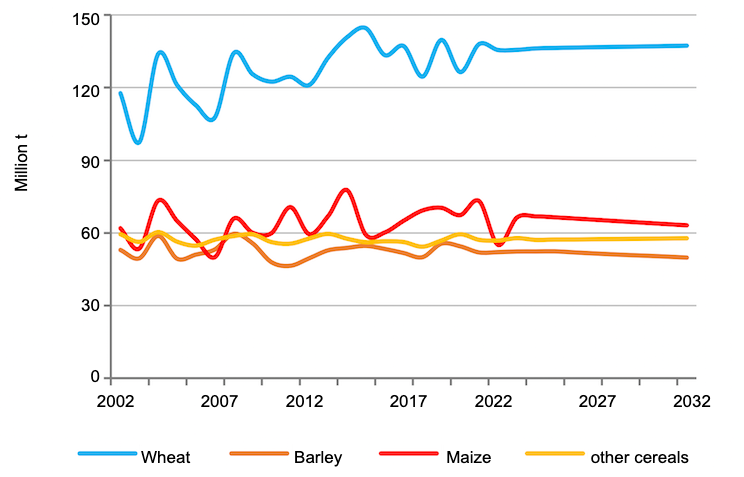Given that the EU cereal area is slightly decreasing and due to lower yields, in 2032 overall EU cereal production is expected to fall to 1.1 million t below the 2020-2022 average production of 309 million t (to 308 million t). The EU’s use of cereals in animal feed is expected to drop to 150.5 million t in 2032 (-6.1 % compared to 2020-2022). At the same time, human consumption of cereals is expected to reach 69.3 million t in 2032 (+3.9 %). Total volumes traded are expected to increase to 78.5 million t in 2032 (+5.8 %), in line with the relative competitiveness of EU producers (greater for wheat and barley, lower for maize and rice). While EU producer prices are expected to come down again slightly over the next 3 years, they are not projected to fall below pre-COVID levels until the end of the projection period (2032).

While the area for oilseed crops is set to decline, average yields are expected to continue to increase (albeit without surpassing historical record yields). Overall EU oilseed production is therefore expected to reach 32.9 million t in 2032 (up from 30.2 million t in 2020-2022), with rapeseed, sunflower, and soya bean production expected to increase by +2.8 %, +14.3 % and +33.3 %, respectively. Given an expanding area and increasing yields, the production of pulses is projected to increase by 2.4 million t and to reach 6.7 million t in 2032.

The EU is expected to remain a net importer of oilseeds and protein crops through to 2032, though growth is expected to taper off, with net imports of oilseeds expected to decline from an average of 20.0 million t in 2020-2022 to 17.5 million t in 2032. This is due to increased production and lower domestic demand. Over the same period, the import of pulses is expected to decline from an average of 1.3 million t in 2020-2022 to 0.1 million t in 2032, driven by domestic production and increasing world market prices. Human consumption of pulses in the EU is also expected to increase (by 55 % between 2020-2022 and 2032), but feed will remain the main use of pulses (3.9 million t used for feed in 2032 compared to 2.6 million t used for food). In most EU countries, the livestock production is projected to decline, which should result in an overall decline in demand for oilseed meal.
December 9, 2022/ EU agricultural outlook for markets, income and environment, 2022-2032/ European Commission.
https://agriculture.ec.europa.eu




